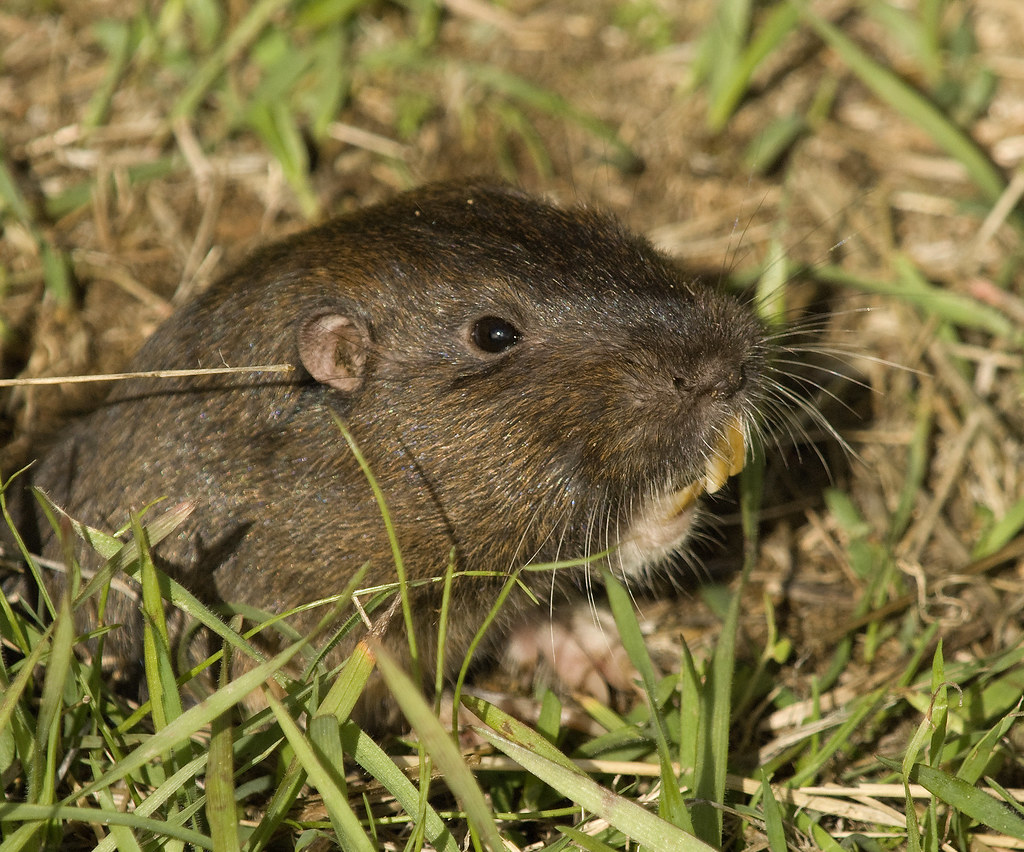How to Get Rid of Gophers and Moles

How can you get rid of gophers in your yard? Try trapping, poison baits, underground fencing, flooding their burrows, fumigation, barn owls, and even some household remedies to get rid of these pests.
Gophers love to make a dramatic entrance, especially when digging their tunnel openings right in your backyard. Your mission is to show them the exit — or at least the way to a neighbor's lawn.
Gophers' highly advanced burrow system may contain more than 500 tunnels and cover up to 2,000 square feet (yikes!). Their burrows are anywhere between 4 to 12 inches underground and about 2.5 to 3.5 inches in diameter. They keep their food storage chamber hidden away 6 feet beneath the surface.
First, though, make sure gophers are tearing up your green carpet. Gophers can be easily confused with moles, voles, and groundhogs. It's critical to know what critter you're up against to find the most effective pest control solution.
A clear sign of a gopher family damaging your land is mounds of loose dirt shaped like crescent moons or horseshoes. Next to the mound, you'll find a plugged hole. Gophers will stop at nothing to get a nibble of your plants, damage your irrigation system, and build their tunnel fortress underneath your lands. How's that for dramatic?
Gophers will cause significant damage to your lawn if left unmanaged, so we have rounded up ways to take back control of your lawn.
Gophers, moles, voles and groundhogs
Gophers
Gophers are burrowing rodents with powerful front paws that are often pink. They often are called pocket gophers because they have external cheek pouches that allow them to carry food and nesting materials.
Depending on the species, gophers are 6 to 10 inches long with a short, hairless tail. These rodents also have large yellowish-brown front teeth that protrude from their mouths when closed.
Moles
Moles are meat-eaters and love to snack on insects, earthworms, and grubs. These little critters have blackish fur and are 4 to 7 inches in length with small, paddle-like feet. Moles have an elongated snout and head, beady eyes, and no visible ears.
Mole mounds are circular, volcano-shaped, and have a plug in the middle that is not distinct. Unlike gophers, moles have feeding burrows right beneath the surface, making a raised path on your land.
Voles
Voles, unlike moles, are vegetarians. They have short tails, small round bodies, little eyes, and partially visible ears, making them easily mistaken for field mice. Voles are 5 to 8 inches long and are a grayish-brown.
Voles' exit holes are the shape of small golf balls and lead out from previous mole tunnels.
Groundhogs
Groundhogs, also called woodchucks, tend to have white teeth that sit inside their mouths when closed (unlike gopher teeth). Groundhogs have dark brown or black feet and a thick, furry tail.
The most significant difference between a gopher and a groundhog is size. A groundhog can weigh more than 10 pounds, while a gopher tends to be under 2 pounds.
How to Get Rid of Gophers
A single gopher can dig several mounds a day. Imagine the damage a whole gopher family can cause to your yard. Gophers gnaw on irrigation lines, sprinklers, and buried cables. Gophers also can harm your plants' roots.
Trapping
Trapping is an effective and nontoxic gopher control method. The best time to trap is in the fall and spring. Common trap types include Victor Black Box, Macabee, Gophinator, and Cinch.
The key to setting these gopher traps is finding the main runway of a tunnel. The main runway will be near a fresh mound. You'll have discovered the runway when your probe sinks 4 to 12 inches into the ground. Stake down two traps into the tunnel facing each other.
If you do not catch a gopher within 2 to 3 days, move the trap to a different tunnel. You'll have trapped your gopher(s) when no new mounds appear.
Poison baits
This control method is very effective but can affect other animal populations such as owls, foxes, and coyotes. Follow all labeled directions when using poison baits.
Spring is the best time to use poison baits, as this is when a gopher's food supply is low. Apply bait to the main runway tunnel and plug the burrow holes after application.
Check the area periodically for two weeks after initial treatment and remove any deceased gopher(s).
Underground fencing
Underground fencing may not remove the gophers from your land, but it can help deter them from your plants. Before planting, bury hardwire cloth or 3/4-inch mesh poultry wire at least 2 feet under raised beds. Bend 6 inches of mesh or wire at a 90-degree angle away from the plants.
Wire baskets also can protect individual plants. Remember to leave enough room for the roots to grow. This solution can be ineffective against a rather persistent set of gophers who burrow under the wires. The wire does have the potential to restrict proper root growth.
Flooding
Flooding gopher holes may force the gophers out of their burrows and expose them to predators like hunting dogs.
Fumigation
Fumigation may seem like the perfect gopher exit strategy, but this method of gopher control doesn't stand up against solutions like trapping and baiting.
Why? Fumigation isn't very useful on gophers, because these pests are pros when it comes to sealing up their burrows for protection.
Barn owls
Using barn owls to control your gophers does come with limitations. For starters, you will need to install barn owl boxes to encourage barn owls to nest on your property.
While you may invite enough barn owls to prey on your gophers, barn owls like to range far from their nesting boxes for food. So even if your barn owl boxes attract barn owls, there is no guarantee the owls will target the gophers so near their home.
Bottom line: Barn owls for gopher control is often an unreliable solution.
Household Remedies
Household remedies to get rid of other pests often are effective, safe for the environment, and save quite a few bucks. That's not the case with gophers, though.
According to the University of California Agriculture & Natural Resources Program, popular household remedies such as gopher purge, castor bean, and garlic haven't been shown to repel gophers from an area. Vibrating stakes, ultrasonic devices, wind-powered pinwheels, and planting chewing gum or laxatives in burrows also are not recommended for gopher removal.
While some devices claim to frighten pocket gophers, these pests don't scare easily. Their resistance is likely due to their exposure to noise and vibration from sprinklers and lawnmowers.
Repellents
According to the University of California program and the Utah State University Extension, there are no effective repellents available to protect plants from gophers.
When to Call a Professional
When it comes to calling your local pest control operator, we say, "go-pher it!"
If you have a persistent family of gophers who aren't deterred by any of the above solutions, a pest control professional near you can offer additional ways to show your burrowing friends the exit.
Main image credit: Chuck Abbe / CC by 2.0

Jane Purnell
Jane Purnell is a freelance writer and actor in New York City. She earned her B.A. from the University of Virginia and enjoys a warm cup of French press coffee.
How to Get Rid of Gophers and Moles
Source: https://www.lawnstarter.com/blog/pest-control/how-to-get-rid-of-gophers/